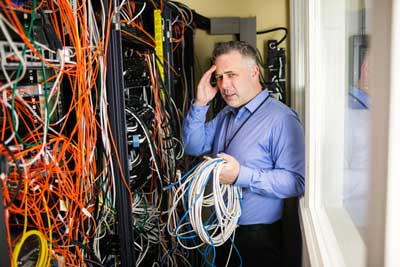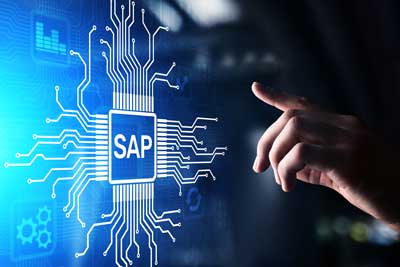
The S/4HANA revolution is here to stay.
For IT professionals using SAP in the supply chain, S/4HANA could mean big changes – but not necessarily for enterprise mobility.
You’ve probably been hearing a lot about SAP’s next-gen ERP suite: SAP S/4HANA. And you may be considering migrating to it. First released in February 2015, the drive to switch over to the new S/4HANA has ramped up significantly as older systems like R3, ERP and ECC go out of support (ECC 6.0 support ends in 2025).
SAP has its own reasons for deprecating these older systems. But for enterprise users, the reality is that these previous-generation technologies cannot keep up with modern digital transformation efforts, such as cloud migration, blockchain, IoT, Industry 4.0 and the present-day API economy.
What does the rise of S/4HANA mean for IT professionals and mobility in the supply chain?
Let’s start with an overview of the basics:
What is S/4HANA?
SAP S/4HANA is the future.
SAP S/4HANA is the next generation of ERP software from SAP, built on their proprietary SAP HANA in-memory platform. As the successor of SAP R/3 and SAP ERP for large enterprises, S/4HANA represents a “transformation shift” in sophistication, simplifying the already intuitive SAP framework even further.
SAP S/4HANA overhauls the “Core” into what is termed Digital ERP Core, an architecture that stimulates future digital transformation efforts in the supply chain, the ultimate goal being a “Zero Touch ERP.”
Gartner’s 2016 prediction is that S/4HANA is expected to reach $7B in market share by 2020 in the U.S. alone, while the global market is expected to surpass $20B. So far, those predictions appear to be holding true.
How is S/4HANA Different than ECC?
Adopters can expect to see significant changes in S/4HANA compared to ECC 6 and legacy SAP software. New hierarchies, table and data structures means moving from ECC to S/4HANA will require careful planning and execution to avoid difficulties, delays or loss of critical data.
While this re-engineered digital infrastructure may represent a significant change from an ERP perspective, from a mobility perspective, upgrading or migrating to S/4HANA will not impact RFgen Mobile Foundations for SAP.
Several RFgen customers have already switched to S/4HANA without interrupting their RFgen environment.
S/4 HANA Deployment Models: Cloud, On-prem, or Hybrid?

SAP S/4HANA is available in both cloud and on-premise editions and may be used in hybrid models using either a private or public cloud.
Many companies are choosing to move to cloud-based deployment to reduce total cost of ownership (TCO), increase speed and secure peace of mind, all the while simplifying their ERP environment and supporting other IT cloud initiatives.
CTOs, CIOs and other CXOs remain at the forefront of this drive, pushing mandatory migrations to S/4HANA and SaaS products over the next five years before the 2025 ECC deadline, according to Gartner. Technology leaders are actively pursuing a cloud-first approach to simplify IT infrastructure, reduce IT costs and maintenance, and align with other IT strategies that interconnect and empower the workforce.
While the “cloud” buzzword is often associated with SAP these days, many customers are choosing a hybrid deployment model using a private cloud instead. 40% of SAP customers surveyed have no plans to move onto the cloud for S/4HANA at all, instead preferring the ease and security of on-premise deployment.
In the end, don’t let buzzwords or tech trends influence you into choosing cloud deployment if on-premise or a hybrid model is a better fit for your organization.
Your deployment model will not affect RFgen’s compatibility with SAP. Because RFgen Mobile Foundations for SAP does install code in your ERP environment, it can communicate with your ERP and business systems regardless of where they are deployed—on-premise, hybrid, private cloud or public cloud.
Why Should I Consider S/4HANA Migration?
Implementing S/4HANA is not a requirement to keep SAP up and running. However, SAP’s over-arching strategy seems to be aimed at phasing out their other software suites in favor of S/4HANA, meaning a move to S/4HANA may be needed eventually.
If you are worried about being left behind—you aren’t. About 5,000 SAP customers are running S/4HANA compared to 35,000 still using ECC. 41% of SAP users surveyed in February 2019 are still evaluating a potential move to S/4HANA.
At RFgen, our SAP consultants have seen a similar trend. Regardless of when you choose to adopt S/4HANA, RFgen’s SAP mobile supply chain apps are SAP-certified for 4.6c to 6.0 EHP8 as well as SAP HANA.
If you are considering making the move to SAP S/4HANA, be sure to run SAP’s Readiness Check to analyze the impact of the changeover.
Before Migrating to SAP S/4HANA

As with any major implementation project, it’s absolutely vital to engage in proper planning upfront. Gain buy-in from all departments involved. Clearly identify the needs, challenges, and benefits of your S/4HANA system.
Understand the full process and cost of migrating to ensure appropriate time and resources can be dedicated to the project.
Since S/4HANA is bound to simplify SAP (but not its prodigious functionality), it may change the way you use your ERP, ideally for the better. Expect to re-evaluate your business and supply chain processes to ensure a smooth transition of data and workflows. Be sure to set aside additional time for training users to get the most out of your new SAP S/4HANA system as well.
RFgen’s mobile UI can assist IT professionals in training staff on the new S/4HANA system by simplifying the complex array of information employees must navigate to perform everyday tasks.
85% of SAP S/4HANA adopters surveyed reported that their S/4HANA implementation met or exceeded their expectations. Most completed their project in 12 months or less (approximately 92%). Of that 15% not satisfied with their experience, the majority failed to take appropriate steps to prepare for their S/4HANA migration.
SAP S/4HANA Migration Scenarios
You will probably fall into one of these three S/4HANA adoption scenarios:
- New Implementation in which the user migrates from a legacy system to a new installation of SAP S/4HANA. A true migration.
- System Conversion where the user changes over their existing system to the SAP S/4HANA system. Essentially an upgrade.
- Landscape Transformation, which involves customers consolidating their landscape and gradually migrating processes into the SAP S/4HANA system over time. By migrating processes associated with only a certain entity (such as the supply chain), organizations can harmonize shared business and master data without having to make an enterprise-wide switchover all at once.
Greenfield vs. Brownfield Approach
SAPinsider identifies two main approaches to S/4HANA: Greenfield, a re-implementation of SAP to create a clean slate, or Brownfield, in which the environment receives an upgrade to the current release.
39% of S/4HANA adopters elect to use a Greenfield approach. One reason for this is due to the creep from customized code added over time, leading the already complex SAP environment to become more complex the longer it’s been in place due.
One of SAP’s greatest strengths lies in its ability to be customized. Here, that very strength can be a challenge to look out for.

Can I implement enterprise mobility with S/4HANA?
Absolutely.
RFgen Mobile Foundations for SAP is SAP-certified for 4.6c to 6.0 EHP8 and SAP HANA and easily integrates with S/4HANA.
RFgen extends the functionality of your SAP software to mobile devices such as barcode scanners, ruggedized tablets, and IoT devices, enabling your team to work where, when and how they need to. RFgen software collects data and communicates transactions bi-directionally with SAP in real-time to help you get more out of your ERP environment.
RFgen Mobile Foundations for SAP can also help you support off-network workflows, integrate voice-directed technologies and mobilize your field services. Included with the mobility ecosystem is the Mobile Development Studio, a mobile app development platform architected for the supply chain running on SAP that enables teams to tailor their software with minimal effort and without requiring outside developers.
Is RFgen compatible with SAP S/4HANA?
Yes. RFgen already integrates seamlessly with SAP S/4HANA.
“Buy It, Build It, Track It, Ship It”
RFgen Mobile Foundations for SAP works with any core supply chain business functions.
RFgen’s pre-written mobile supply chain apps for SAP have been architected to talk with the ABAP SAP programming language and common bolt-on supply chain modules, such as MM (inventory movement), LE (shipping), PP (planning data and POs), PM (plant maintenance/assets), FICO (financial accounting and controlling), and others.
Migrating with Custom Code
Leading S/4HANA adopters have found cleansing data and custom code during migration to be a major hurdle. SAP is not a one-size-fits-all platform, so customization is par for the course.
This RFgen eases this challenge considerably because it does not add any custom code to your SAP environment.
Migrating Your SAP Database

Since RFgen does not use a separate database, instead initiates transactions directly in SAP, moving from other versions of SAP (like ECC 6.0, R/3 and Business Suite) to 4HANA will not require an overhaul of your RFgen environment.
Changes to the S/4HANA proprietary database will not affect your RFgen software. Minimal modifications may be required to update your connections between RFgen and the new database.
Otherwise, RFgen customers have found the changeover to S/4HANA easy and painless.
How RFgen Accelerates the Benefits of SAP S/4HANA
RFgen extends the lifespan of your SAP environment by expanding its functionality with enterprise mobile technology for the supply chain. Not only does the RFgen ecosystem help you get more out of your ERP, but it can also enhance the benefits gained from SAP S/4HANA.
SAP S/4HANA |
RFgen for SAP |
|---|---|
| Simplify SAP through better design, UX, mobility, and adoption of SAP Fiori. | Condense complex SAP data into simple, purpose-built mobility UI. RFgen can reduce training for mobile users by 80%. |
| Streamline and automate core supply chain processes. | Automate data capture with ADC, barcodes, and process automation through mobility. |
| An exponential increase in speed. | RFgen can increase efficiency by 25% and productivity by 30% (on average). |
| Integrate big data, AI and embedded analytics. | Uses your ERP’s analytics and reporting. |
| Spur future digital innovation and transformation. | A digital supply chain transformation technology that sparks additional SCM initiatives. |
| Create a platform for interconnected ecosystems and networks. | Easily enters the stack interconnected with your SAP ecosystem. |
| Increase confidence in SAP system, trust between IT and business. | Inspires trust with SAP system among users, managers and customers by driving 99+% inventory accuracy. |
LEARN MORE: RFgen Mobile Foundations for SAP »
When should I implement RFgen mobility with SAP S/4HANA?
When implementing, upgrading or migrating your ERP system, it’s always a good idea to “settle in” to your new environment. During this period, try to iron out kinks in your SAP and internal processes. Once these workflows are running smoothly, then consider bringing in an enterprise mobility solution like RFgen.
Mobile business processes will have their own workflows to analyze, implement and troubleshoot. Instead of trying to sort through your core ERP processes AND mobile processes simultaneously, it’s best to solve one major project before complicating the implementation with another major change.
In the experience of our senior SAP consultants, avoiding concurrent implementations is critical to ensuring the success of both projects.
Mobile Apps: SAP Fiori vs RFgen for S/4HANA
Fiori continues to drive the SAP user experience in S/4HANA. But when it comes to developing mobile supply chain apps, RFgen’s Mobile Development Studio is a more appropriate tool. While Fiori can be used to create mobile apps, RFgen is architected specifically to create mobile apps for supply chain processes. Mobile Development Studio essentially empowers you to create supply chain mobile apps faster, easier and with fewer headaches using a low-code environment based on modern design concepts.
Also note that Fiori may cost more to customize and maintain than RFgen, and may require third-party developers, which RFgen does not.
RFgen Mobile Foundations for SAP includes Mobile Development Studio as part of its inherent ecosystem.
LEARN MORE: Creating Mobile Apps for the SAP Supply Chain: Fiori and RFgen
How Much Experience Does RFgen Have with SAP?
RFgen has been providing guided consultations for mobile data collection, fixed asset tracking and ERP mobility since 1983, and has been SAP-certified since 2004. Our talented team enables you to leverage the experience and expertise of our senior SAP consultants to save you the cost of hiring a third party. Since our SAP experts are also supply chain experts, RFgen lends you double the proficiency and know-how.
Learn more » Our Enterprise Mobility Experts
The Bottom Line: S/4HANA Sets the Stage for Future Digitalization
Perhaps the biggest takeaway to know about SAP S/4HANA is that it is the future of the SAP platform. As a cornerstone technology in your enterprise, a move to S/4HANA can support directives to boost agility and flexibility while driving down costs.
By simplifying the robust SAP system, S/4HANA can lead the way for digital transformation in other areas of your enterprise—including enterprise mobility.
As the premier mobility solution for SAP, RFgen Mobile Foundations boasts digital simplification, ready-to-run supply chain business processes and automated data collection with mobile barcoding, setting the foundation for continuing digital evolution in your enterprise.
RFgen can help you facilitate business insights through automated capture of real-time data as you architect a sustainable digital strategy for innovation and transformation going forward.
Additional Sources:
- SAPinsider. “SAP S/4HANA Migration: State of the Market Webinar.” Webinar. May 15, 2019.
- IBM Corporation. “How to Prepare a Successful, Secure SAP S/4HANA Deployment to the Cloud.” Webinar. May 2019.






